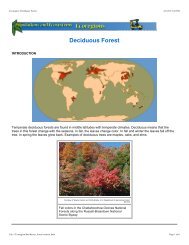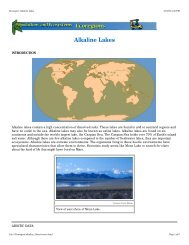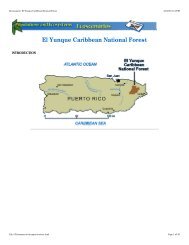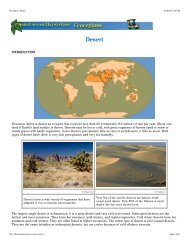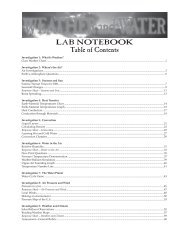Ecoscenarios Combined - FOSSweb
Ecoscenarios Combined - FOSSweb
Ecoscenarios Combined - FOSSweb
Create successful ePaper yourself
Turn your PDF publications into a flip-book with our unique Google optimized e-Paper software.
Ecoscenario: Monongahela National Forest<br />
4/16/03 3:20 PM<br />
Courtesy of John Warner<br />
Blackwater Canyon is privately owned land<br />
that borders Monongahela National Forest. It<br />
has recently been opened to logging.<br />
Courtesy of Steve Holmer, American Lands Alliance<br />
Temporary road cut through<br />
Monongahela National Forest to remove<br />
felled trees.<br />
In most logging operations, roads are built to get equipment and trucks into the area. Logs are hauled offsite to a mill, cut<br />
into boards, and sold by the lumber companies.<br />
Logging in West Virginia<br />
In the early 1800s, the forests of West Virginia were filled with large spruce, hemlock, white oak, and poplar trees. These<br />
trees were attractive to logging interests, which began clearing the trees for lumber. Spruce and pine trees were the first<br />
trees cut, because their trunks float in water, making transportation to sawmills easier. When the spruce trees had mostly<br />
been cut, logging efforts focused on other species. Black cherry and white oak were the most valuable timber hardwoods.<br />
At first, lumbering progress was slow because it used inefficient techniques like simple cross-cutting and water-powered<br />
mills. In 1880 circular saws and steam engines arrived, and large-scale "production" milling began. A few years later,<br />
logging techniques advanced with the addition of band saws, which could cut logs into boards very quickly. It would take 7<br />
hectares (17 acres) of trees a day to keep a band-saw mill running. A new type of locomotive engine, called the Shay<br />
locomotive, further increased logging activity. Because it could climb hills and make sharper turns, this engine allowed<br />
trains to be used to remove logs.<br />
Between 1880 and 1920 most of the forests in West Virginia had been logged. When large trees are cleared from a forest,<br />
there are fewer living plants to help keep the soil intact. Silt and soil ran into streams, polluting streams and the<br />
downstream watersheds. The ash and soot from forest fires in the area, started by Civil War activity or logging operations,<br />
further damaged waterways. Because people need fresh water for drinking, bathing, agriculture, and industry, this pollution<br />
was not desirable.<br />
file:///Ecoscenario/mononga/content.html<br />
Page 8 of 11



